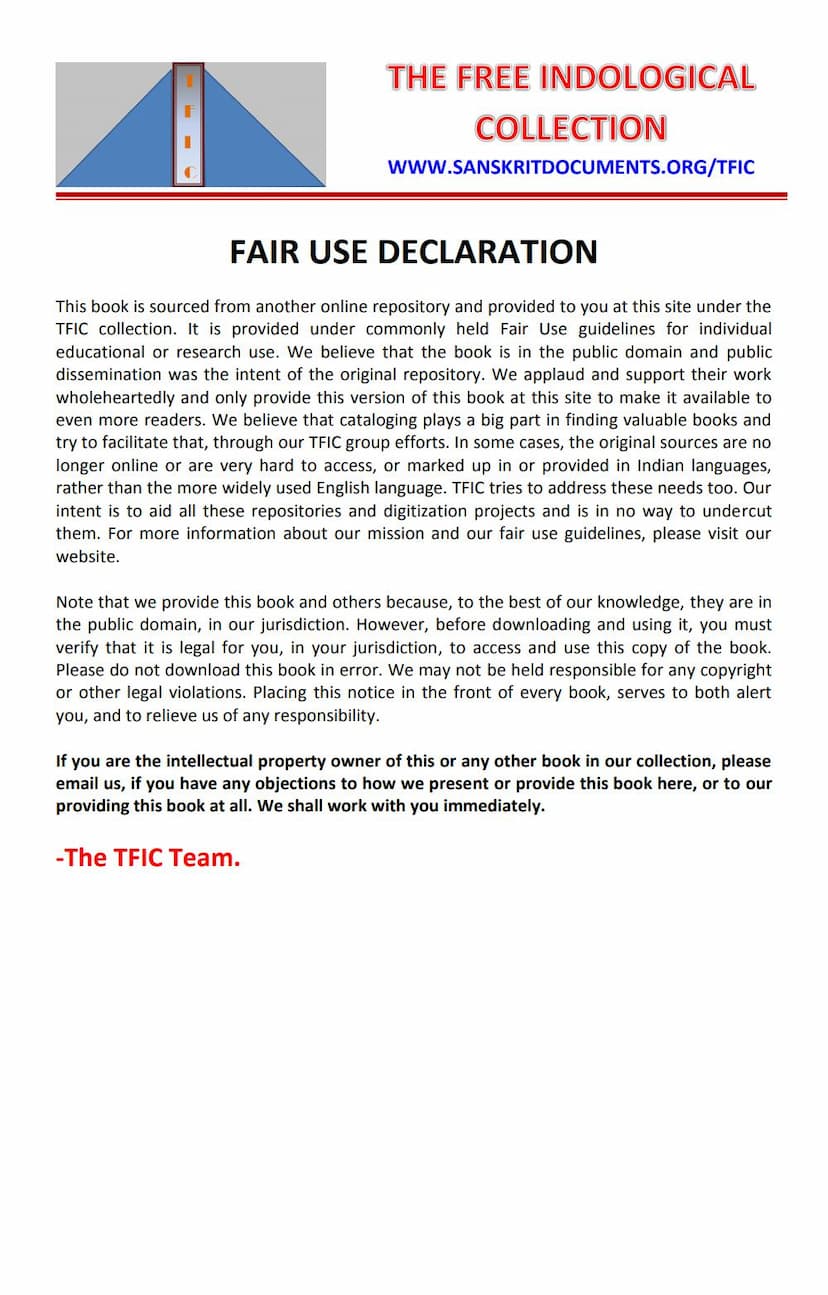Siddha Siddhanta Paddhati
Added to library: September 2, 2025

Summary
Here's a comprehensive summary of the Jain text "Siddha Siddhanta Paddhati" by Kalyani Mallik, based on the provided document:
Book Title: Siddha Siddhanta Paddhati (and Other Works of the Nātha Yogis) Author: Smt. Kalyani Mallik Publisher: Poona Oriental Book House, Poona Publication Year: 1954 (First Impression)
Overview:
This book is a significant scholarly compilation and analysis of several key texts attributed to the Nātha yogis, a prominent spiritual tradition in medieval India. Edited and introduced by Dr. Kalyani Mallik, the work aims to bring previously unpublished or scattered manuscripts of the Nātha tradition to the attention of scholars. The core of the volume is the critical edition of "Siddha Siddhanta Paddhati" of Gorakshanatha, alongside other important Nātha texts.
Key Contributions and Contents:
-
Siddha Siddhanta Paddhati (SSP) by Gorakshanatha: This is the central text of the collection. The book presents a critical edition of this work, collating manuscripts from various locations like Jodhpur, Hardwar, and Tanjore. The SSP is described as a cryptic but valuable work that expounds a form of Yoga associated with Gorakshanatha. It is divided into six Upadeshas (sections):
- Upadesha I: Origin of the Body (Pindotpatti): Discusses the creation of the body from the Supreme Reality, the concept of Anāmā (Nameless One) and Shakti, the five elements, and the stages of embryonic development.
- Upadesha II: Discussion of the Body (Pindavichara): Focuses on the inner environments of the body, including nine nerve centers (chakras), sixteen supports (ādhāras), three points of concentration (lakshyas), and five firmaments (vyomans). It also details the yogic practices like Mudras and Bandhas, suggesting potential connections with Buddhist Vajrayana.
- Upadesha III: Knowledge of the Body (Pindasamvitti): Explains the identity of the microcosm (human body) with the macrocosm, detailing the locations of various cosmic elements and deities within the body. It emphasizes that liberation is achieved when the mind registers no sense impressions.
- Upadesha IV: The Foundation of the Body (Pindadhara): Focuses on Shakti as the support of the body, describing her various aspects as Kula and Akula. It highlights the importance of Kundalini and the concept of the body as an epitome of the universe.
- Upadesha V: Union of the Body with the Supreme Reality (Pindapadasamarasa Karana): Discusses the equilibration of the body with the Supreme Reality (Paramapada) through the Grace of the Guru. It emphasizes that true knowledge and union are attained through the Sadguru.
- Upadesha VI: Definition of an Avadhuta Yogi (Avadhuta Yogilakshana): Describes the characteristics of an Avadhuta Yogi, who is free from all bondages and controls the senses, mind, and body. This section also compares the attainments of an Avadhuta with Siddhas from other sects and highlights the guru's role in initiating disciples.
-
Other Nātha Texts: The collection also includes the following texts:
- Yogavishaya by Minanatha (Matsyendranath): A treatise on attaining salvation through Yoga, detailing nerve centers and the importance of the Guru.
- Amaraughaprabodha by Gorakshanatha: A work on Laya Yoga, Hatha Yoga, Mantra Yoga, and Raja Yoga, aiming to prepare individuals for Raja Yoga. It discusses the nature of the body, the importance of Bindu and Nada, and the stages of Yoga practice.
- Yogamartanda by Gorakshanatha: A comprehensive text on Yoga, covering Asanas, Prāṇāyāma, Pratyāhāra, Dhāraṇā, and Dhyāna, with many shlokas similar to those in the Hatha Yoga Pradipika.
- Gorakh Upanishad: A text in mixed Hindusthani and Rajasthani, explaining the meaning of Goraksh Upanishad and discussing the nature of the Natha deity, including the concept of nine Nāthas.
- Matsyendraji-ka Pad: A devotional song praising Matsyendranath.
- Bhartrihariji-ki Sabdi, Chirpatji-ki Sabdi, Gopichandaji-ki Sabdi, Jalandhari Paoji-ki Sabdi: These are popular songs or eulogies of various Nātha yogis who renounced worldly pleasures. They are written in a mix of colloquial and pure Rajasthani.
Introduction and Foreword:
- Foreword by Rao Bahadur P. C. Divanji: Highlights the significance of the collection, emphasizing Dr. Mallik's assiduous work in procuring and editing the manuscripts. He praises the Nātha yogis for preserving the ancient Hathayoga tradition and notes the interrelation between the SSP and Yogamartanda, as well as the unique insights offered by Yogavishaya. He also discusses potential authorship issues and the linguistic challenges of the texts.
- Preface by Kalyani Mallik: Expresses gratitude to those who assisted in the project, including Dr. B. B. Dutt and the publishers. She states the book's purpose is to make these "unpublished manuscripts on Nāthism" accessible to scholars.
Scholarly Significance:
- Historical Context: The book provides valuable insights into the history and philosophical doctrines of the Nātha yogis, who played a crucial role in medieval Indian mysticism.
- Textual Criticality: Dr. Mallik's critical approach to the manuscripts, including collation and comparative notes, is a significant contribution to understanding these often obscure texts.
- Linguistic and Philosophical Analysis: The work addresses the linguistic challenges posed by the manuscripts, which are often in mixed languages or not strictly grammatical, explaining this as a deliberate choice for popular understanding. It delves into the philosophical underpinnings of Nāthism, including the concepts of Siva-Shakti, the Avadhuta state, and the practice of Hatha Yoga.
- Preservation of Tradition: By publishing these texts, the book helps preserve the teachings of a tradition that had largely become confined to a small esoteric group.
- Interdisciplinary Connections: The introduction and foreword touch upon the connections between Nāthism, Buddhism, Tantra, and the Sant tradition, offering a broader perspective on the spiritual landscape of India.
In essence, "Siddha Siddhanta Paddhati" edited by Kalyani Mallik is a foundational work for anyone interested in the Nātha yoga tradition, offering rare texts, critical analysis, and a comprehensive overview of their practices and philosophy.